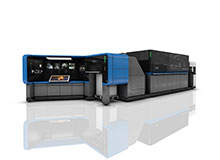

CRA: What does nanography add to the digital printing industry?
GM: Digital printing, even though its been around since 1993, has made a very small impact so far on the vast volume of printing production, and what Landa technology will do is take digital printing into short-to-medium-large format for the first time.
CRA: How does the nanography printing process differ from more traditional methods?
GM: It uses a completely different type of ink. It’s also different because the technology ensures that every page that is printed on a b1 format – the size of the packaging that we’re producing here – can be different. The cost of production is significantly reduced because we’re not using printing plates [the more costly traditional method is better suited to long printing runs], and we’re using a significantly less amount of ink to create the same image density. We use the conventional lithographic printing process, but we use a rubber blanket instead of plates to apply images to a substrate – so the image is created directly on to a blanket, not a plate, and it’s created as a laminate. The blanket is heated so the water is evaporated out of the ink, instead of once it’s on the paper. The ink, when it starts life, is a dry powder. We add water to it to create a suspension so it can be carried around in the press. When the blanket comes into contact with the substrate, a dry laminate is transferred and sticks very firmly to the contours of the substrate. It doesn’t penetrate the substrate at all, so there’s no leakage.
CRA: What benefits does the technology offer?
GM: It has a very high resolution, so there’s no smudging or dot gain and it also has a very strong colour density because the nanoparticles don’t refract light in the same way that conventional ink particles do. You use an awful lot less ink to create the same colour density. That’s why it’s so commercially attractive.
Also, when you reduce conventional ink down to nano size, it changes the properties of the ink. Nanoink covers a considerably greater surface area and creates a much stronger colour. The byproduct of that is that it extends the colour gamut you can create using CMYK by 15 – 17%. If a brand uses a special colour, they usually have the extra cost of custom plates, ink, productivity and longer timescales. Quite a few brand owners are looking at their special colours and looking at whether they can bring these into the CYMK range once nanoink launches.
CRA: Why will nanography appeal to brands concerned with effective packaging?
GM: Two reasons. One, digital printing has made virtually no impact in the packaging market because the market is geared around a fairly large format: B1 sheet [1000 x 707 mm] -there’s nothing on the market that prints digitally at that size. Secondly, there are a number of factors affecting packaging at the moment. There are a growing number of people living on their own, meaning brand owners have to cater to single-person packaging. It doesn’t mean they’re ordering less though: it means they’re ordering smaller runs, more often. Another reason is, in the past we haven’t had a lot of personalization in packaging. Coca Cola’s Share A Coke campaign is a good example of how this is changing. That was a fairly limited personalization – just 150 names in the UK – and this was because of the limitations of conventional printing. With nanography, you can increase the number of names, with none of the extra cost.
CRA: What kinds of packaging can nanoinks currently be used on?
GM: The first beta test site presses are going in next year. The customers who have pre-ordered are in the folding carton market, the label market and also flexible packaging.
CRA: Will nanoink offer a durability that conventional inks cannot?
GM: Our initial tests suggest that it’s a very tough pigment when it’s sitting on the substrate, to a point where it doesn’t need additional protective protection. A lot of brands will still use coating, for cosmetic effect, but the ink itself is an inert substance, so it doesn’t react to heat, light, water, freezing or contact with other chemicals. You can heat-laminate it too. There’s not much you can do to damage it, apart from setting fire to it.
CRA: Is nanoink environmentally friendly?
GM: It makes a contribution to environmentally minded printing. With nanography, you use a lot less ink, so we’re using a much smaller amount of raw materials. Secondly, when we recycle nanoinked packaging, in can be de-inked – in other words, you can remove the ink and reuse the packaging material. Nanography uses a lot less energy, and we’re not moving large quantities of either oil or water around the country, which is how we transport our ink at the moment. Nanography will be delivered to the printer in powder form and the printer will apply his own water to it, reducing costs and energy waste.
CRA: What other benefits does nanotechnology in food product packaging offer?
GM: The security aspect is certainly of particular interest, to the pharmaceutical industry in particular. Manufacturers are concerned about ensuring there isn’t counterfeiting of their drugs. Because each image printed with nanoinks can be different, it gives quite a bit of scope for security techniques to be built into pharmaceutical packaging. I doubt this would matter when it comes to something like cornflakes, but it might be handy with food products where security is an issue. Also, in a country like India, where you have many different languages, the ability to produce multiple specific language versions of packaging is a very attractive proposition, whether your printing newspapers, food product packaging or packaging for toys.
Follow Stephanie Phillips on Google+



